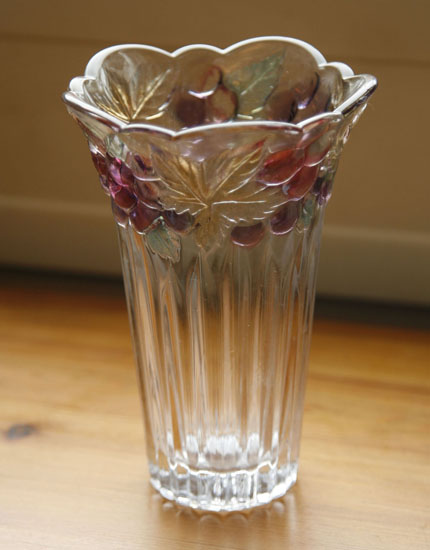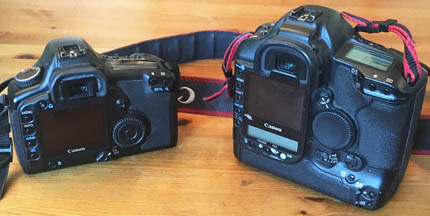Recent Camera Woes - 05/09/2018
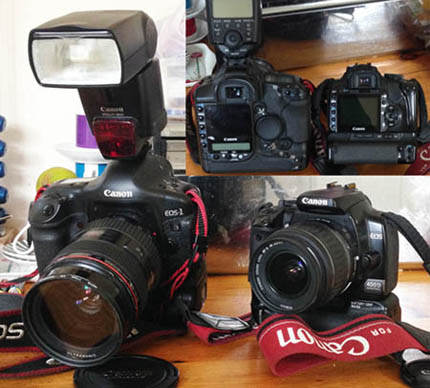
Until recently - my main camera for website and article photos - Canon EOS-1D full frame camera, fitted with Canon EF 24-70mm F2.8L zoom lens and Canon Speedlite flash - an excellent combination for workshop work - even if the combined weight is on a par with a Manx 350 engine.
Compare it with my previous camera - Canon 400d with extra battery pack - about a third of the size and that had its own inbuilt flash
Photography and camera equipment - not something I have talked about here before, but recent woes and purchases have bought the subject to mind. This is (yet) another interest/hobby that I have dipped in and out of since I was a teenager, and I suppose another one of those subject areas where my original interest was kindled from my father and his interest in it when I was a child.
I am not really sure which element of photography I like more, the art of photography itself or the playing about with camera equipment and all the clever things they can do – just like building bikes and riding/racing them really, it is partly appreciating the quality and features of the equipment and partly learning how to make best use of it.
I do know that I can appreciate a really well taken photograph taken by a professional photographer – no matter what the subject matter, and I can see there is definitely a skill to doing so. In the most exceptional of cases I can see why it is considered an art form in its own right. I remember a few years ago when working for Selfridges in London, they had a large section of specialist books covering art and photography and I would often spend a lunch break leafing through one of them – envious at how those photographs were so different to the ones I take.
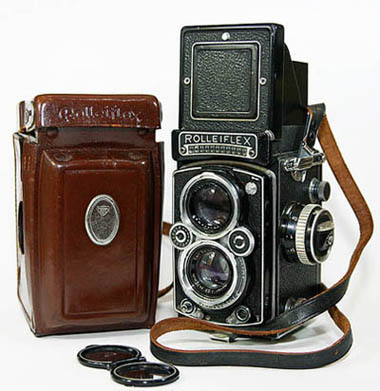
Rolleiflex medium format camera from 1940's-50's. This type of camera took a roll film wider than 35mm and you looked through the viewfinder on the top of the camera - good for stills and portrait photography
I remember my father using a similar camera in the 1960's
And for the other 95% of photographs I take – the modern world of digital photography has one really big advantage . . . you can just scan through them and then delete – I have almost forgotten what it was like to only have 24 exposures on a film, have to pay to have them developed, then another trip to collect, only to find only one photo on the film worth keeping!
Pre-Digital Photography
In the 1960’s my dad had both 35mm (i.e. 35mm wide negative) and what used to be called ‘medium format’ cameras - the latter being, a format used mainly by professionals – he having a couple of upright Rollei’s - similar to the camera shown on the right, although I think my father's was a more basic model than the one shown here. He used to do a lot of ‘slide’ photography and I was always taken with the vibrant colour’s they gave – Kodak Ektachrome being the film of choice and a format I liked using myself years later.
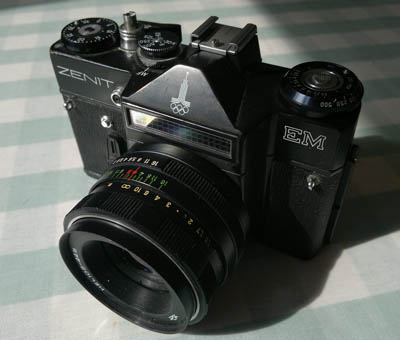
My first SLR camera was a Russion Zenith EM model, pretty much identical to the one shown here. It was considered an entry level into the SLR world in the 1970's - but very popular and I took a lot of photos withi one of these - including some I developed and printed myself
Zenith - Russian SLR
My first ‘proper’ camera was a Russian Zenith SLR bought as a teenager with one of my first pay checks, which I vaguely remember being around 1980-81. Although clunky, it was built like a (T34) tank and could sometimes take a reasonable shot. Although Zenith was not considered a prestigous brand - it had most of the functions that the more expensive SLR cameras such as a Pentax or a Nikon had - therefore was a good platform for learning the rudiments of photography.
Using this, I soon developed enough of an interest in the hobby of photography to teach myself the basics of how to adjust the mode and settings to suit the type of photograph I wanted to take, and that much of photography is a compromise to best suit the situation. Action sport - i.e motorcycle racing needs high shutter speeds to avoid blur, that means less light. Portrait photograpy can be much lower speeds, but you need to think carefully about depth of field to determine subject matter focus compared to background etc etc.
So in those first early days I used to take lots of films - but realised it was not as easy as it said in the books! . . . I look back now at all the films I had developed and can see that approximately 80% of the photographs I took were not much cop. Mind you,
I am glad that I did because if nothing else, a photograph - no matter how poorly taken, is a reminder of a particular time in your life, so occasionally scanning through them like i did for this article is a great way of remembering old times.
Zenith SLR Photos:
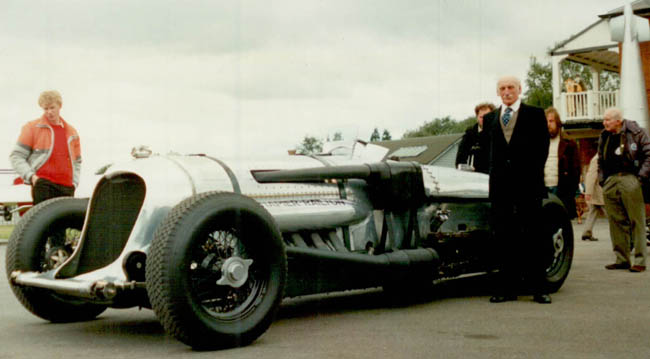
I think this photo was taken in 1983 and shows my old friend (and a Brooklands Gold Star holder himself) - the late Bob Pike, here stood next to the famous Napier-Railton that in the hands of John Cobb took the ultimate Brooklands lap record in 1935 of 143.44 mph. Bob was a very interesting character himself, having first worked in a motorcycle shop at a very young age in the 1920's and owning his own shops by the 1930's. I remember him telling me he lost almost all his stock including his Manx Norton's when his London shop was bombed in the Blitz. I believe he also won the 1938 Hutchinson 100 at Brooklands, as well as gaining his Gold Star on a Norton around the same time
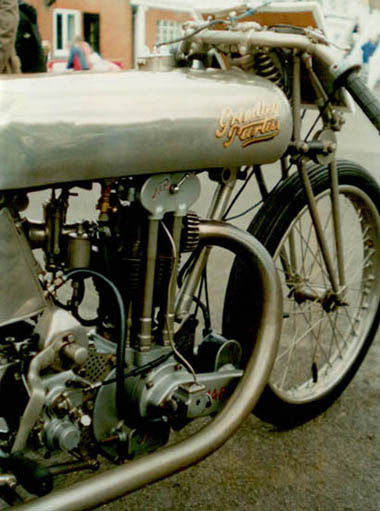
Taken at the same Brooklands meeting in 1983 is this Grindley Peerless Brooklands bike. Not a bad photo - but I have purposefully not tried to improve it with Photoshop (a wonderful modern editing tool not available back then!) and you can see that the engine detail is slightly under-exposed
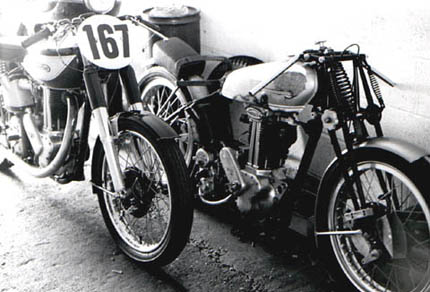
And this photo probably about 1986-87 - and reminds me I liked to mess around with black and white film as well in those days.
Bikes are my two early road racing Norton's, on the left 1948 plunger, and still being built on the right 1938 rigid - both using 38-47 OHV engines.
Around this time I had the use of a friends darkroom and experimented with developing film myself - but too much like hard work!
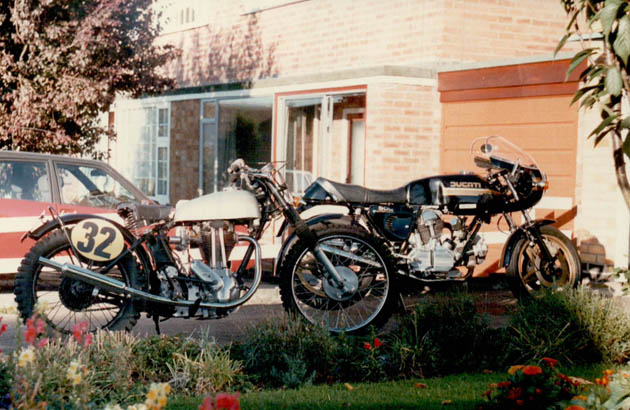
Final Zenith photograph - taken on the driveway of my parents house - probably around 1986, my Norton 500T rep (in grasstrack race trim with lumpy cams - a bit of a handful against proper JAP engined grasstrackers, hence why I built the Rotrax JAP) and 1980 Ducati 900SS - still relatively modern when I bought it in 1983 - fantastic vee twin
Medium Format Toe Dipping
I also had a brief flirtation with medium format myself, buying an upright twin lens Yashica that was retro even then, and occasionally did a bit of my own developing in a friend’s darkroom.
At the time I could not find a second hand Rolleiflex for sale - dont forget this was pre E-Bay, so would have had to rely on what was for sale in the popular high street camera shops that were popular then, but seem to have died out in the last 15 years.
Eventually I did find this slightly cheaper alternative - a Yashica-C, whcih had all the same features and general construction as the Rollei's.
I quickly realised why this upright format of camera was most commonly associated with portrait photography - because the process of having to look down at the viewfinder from the top (and having to open the 'doors' of the viewfinder first) and interpreting the subject matter upside down, was quite difficult and time consuming. Added to this, the photographs it produce were more square in format than rectangular, the upshot being - it was not the sort of camera you could easily just pull out and snap a few frames off - you needed to think more about the setup.
Never the less, it was an interesting interlude and I did take a few reels before giving up on this format - I have included a few ot them here. I think I traded this camera in as part-ex against my next camera - a Canon T70 of which more below.
As for quality - not bad, but I dont think the Yashica was in the same class as the more expensive Rolleiflex's . . .but that could just be a poor workman blaming his tools!
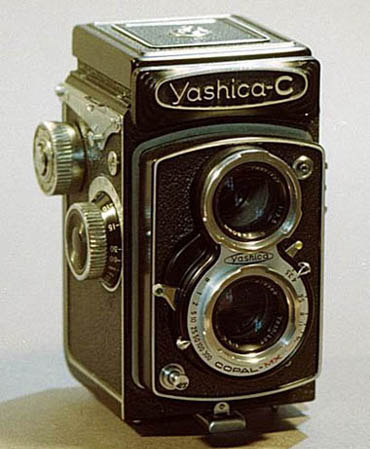
I had a go at medium format myself in the late 1980's, buying an old twin lens Yashica - simiar to the one shown here. You had to get used to looking at the subject matter upside down in the viewfinder if remember correctly!
Yashica Medium Format Photos:
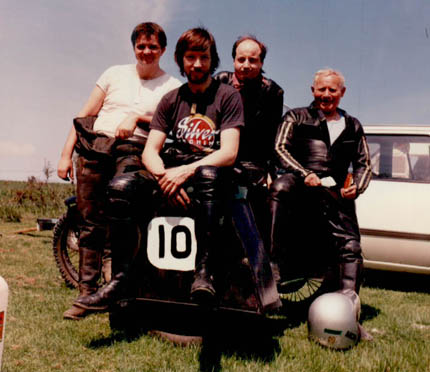
As you can see - the Yashica gave an unusual 'portrait' format. This photo looks like it was taken either at Chalfont Hillclimb or a VMCC grasstrack in the late 1980's. It is a nice group shot of Steve Allen, his passenger Richard, myself and his father Titch Allen. At this time both Steve and Titch were sidecarring Norton's with Richard and myself in the chairs - and myself normally solo as well - times of which I have very fond memories
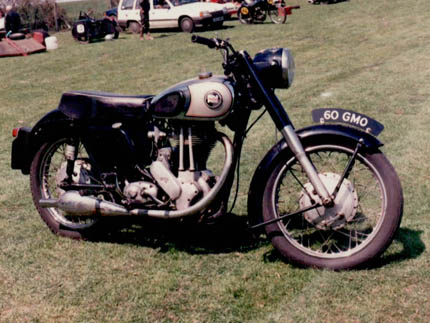
Taken at the same meeting (you can just see one our sidecar outfits in the background) I took this photo of a spectators ES2 as it was very similar to one I owned at the same time. From a technical perspective though - looking at it now the colours do not look very vibrant and not as pin sharp as i would have liked
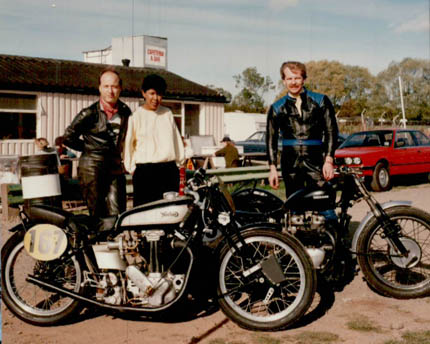
Late 1980's at Mallory, with Sandy (girlfriend then - not wife) and Martin Sibson whom I passengered with on his Triumph outfit. Also solo on my Norton.
Again, taken with Yashica - but I think photo was taken by my best mate Mak, as it was not the kind of camera you could just thrust upon a passer by!
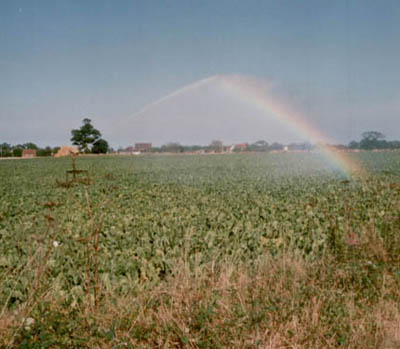
Unusual photo of a field in Norfolk where the crop was being watered by an automatic sprayer. The sun reflecting off the spray gave this unusual rainbow effect - interesting enough for me to stop the car and get the Yashica out
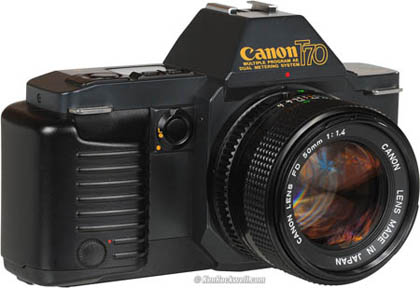
My first decent 'modern' camera was a Canon T70. Just like the one shown here, I fitted mine with a better quality f/1.4 lens, over the standard f/1.8 lens (notice it is quite wide), making it more capable in low light .
Still pre-digital but a really nice camera
Electronic Era - Pre Digital
In the late 1980’s I upgraded to my first electronic SLR – a Canon T70, still a long way from digital, but it gave me a brand loyalty for the make that has followed through to the present day – a bit like the Volkswagon Golf owner I suspect – decent build quality and in my humble opinion, rivalling Nikon as best overall manufacturer for features and lens quality. Mind you, I suppose like many with brand loyalty – there is an element of just going with what I know, mixed with liking their overall packaging and styling.
Anyway, the T70 Canon was I remember being one of Canon's then range of next generation electronic SLR camera's and incorporated one of the first digital information windows - just visible in the accompanying picture on the top right side of the camera.
The T70 was part of the well known Canon T range - which consisted of T50,T70, T80 and the awesome T90 - a camera I wished I could have afforded in those days, but by the time I was in a position to do so, they had become outdated by the introduction of digital camera's.
This range of camera's still used manual focus lens (called the FD range), but no longer needed the film to be manually loaded and wound for each shot. I remember at the time thinking this was the height of
technology - I just placed the film in the back, closed the rear door and it automatically loaded the film. Then just press the button to take a photo and it autoamtically wound on ready for the next photograph. Much quicker than the old manual method of winding - although not as fast as the professional motor drives fitted to the more expensive cameras.
I bought mine second hand from Cecil Jacobs in Leicester - but paid extra for the better quality f/1.4 aperture lens (standard was f/1.8
on a 50mm lens), even though it cost approximately twice as much as the comparitive f/1.8 version. Later I also bought a pro quality Sigma 80-210mm zoom lens for it, but realised that I was just not much cop at motorsport photography, and frankly most of the time - could not be bothered
I kept this camera for many years and took lots of photographs with it - I thought it was a really excellent camera. It was not too big and bulky and was well made and good quality. Added to that i thought the lens was excellent quality and it's larger aperture setting did allow for better photographs in low light.
Because early digital camera's were very expensive and most of them I remember being more of the point and shoot variety - i.e. fully automatic, similar to the type of cameras fitted to mobile phones today, I held off replacing this camera for a digital until about 2006. When eventually I could afford a reasonable digital SLR - when I purchased another Canon - the Canon EOS400D that I describe below
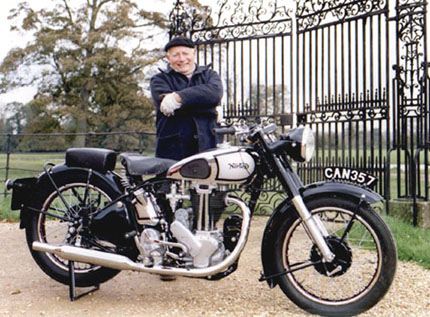
A photo I really like of VMCC Founder, Titch Allen, looking typically cheerful as I best remember him. Taken with the Canon T70, I would guess this is mid 1990's and is at Stanford Hall Lutterworth, where Titch was curator of the bike museum. Bike is my families 1947 Model 18 shortly after I restored it, when it resided at the museum
Canon T70 Photos:
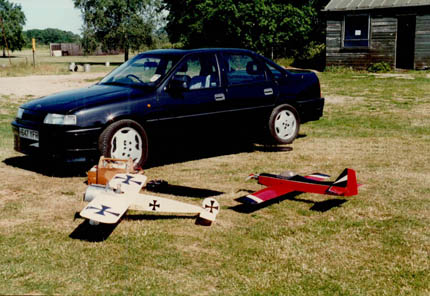
This and photo on the right were taken in the late 1990's at the radio control flying club I was a member of near Market Harborough, using the Canon T70. I remember the photos often looking much richer in colour than with the previous Zenith. Digging out this photo reminded me of the GSI Vauxhall we used to own, as well as a couple of the planes I used to fly - as so often happened with RC planes, the one on the right had a sad demise shortly after this photograph
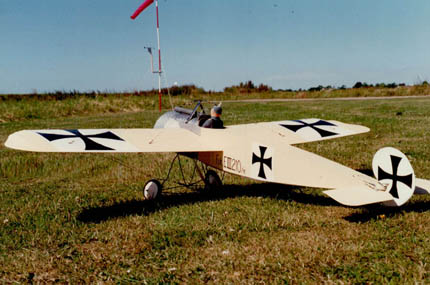
Another photo in the same session of the Fokker Monoplane radio control plane taken at the airfield. Again, rich colours but I notice the print (photo) not quite as sharp as some more recent digital photos I have taken. I think this is probably more a trait of pre-digital photos almost always being processed onto 4 x 6 photos by the development labs, unless you asked specifically for blow ups
Digital Photography
My first digital camera was the Canon EOS400D - which was a relatively early version of their very popular range of 'hobbyist' digital cameras - which I gather has now evolved into the current version - the EOS800D. This range are all commonly defined for using the APS-C image sensor type - these being sensors that are smaller than 35mm, hence them being commonly referred to as 'cropped frame' camera's. These are still excellent camera's - and in the case of Canon and most of the other well known makes - far better quality than all but the best pre-digital, but not producting the same quality images as the best professional cameras, which will use 'Full Frame' format.
I used the 400D for a lot of the photographs used on the RacingVincent website up until about 6 years ago and found it to be an excellent camera -with most of the features you would expect from any SLR digital camera. It also had a really good quality inbuilt flash. Not as powerful as an independent specialist flash unit - such as Canon's 'Speedlite' range, but definitely better than independent units I remember using in pre-digital days. And of course the major advantage with the inbuilt flash - if you need to use a flash it just flips up automatically and no additonal fussing about fitting a seperate unit is necessary.
When I bought mine I bought it new (a very unusual thing for me ...
I am normally too tight to buy anything substantial new!) as a kit, directly from the Canon online distributor. As well as the base camera and a 'standard' quality, portait format zoom lens (I think @28-80mm), it also came with an additional battery pack grip, and an 80-210mm telephoto lens. In truth, I have hardly ever used the telephoto lens, but the extra battery grip was always handy and if nothing else - made it look a bit more like the more expensive professional range! This camera is shown alongside the EOS 1D as a comparison in the first photo in this article.
Canon EOS-1D - but the pro's and con's of buying second hand
So it was about 6 or 7 seven years ago I was thinking I could really do with the next step up with lens quality, something better for low light - and maybe a better quality flash unit - particularly for taking photographs of the items we list on the website. I had been well aware that Canon's main pro camera was the EOS 1D full format camera, and started looking at what prices were for second hand 1D bodies on E-Bay.
I know there is a lot of noise out there about buying used camera's - particularly high use, second hand professional camera's - but by looking through the listing carefully and bearing in mind the normal description pointers that give you the tell tale hints of those worth bidding on and those to avoid - the risk of buying one can be minimised. The upshot of this is that I was able to buy an earlier Mk IIn EOS-1D body for a fraction of the price I would have had to pay for the current version of the model brand new. I thnk mine was about 6 years old when I purchased it (i.e. 2006 vintage?) - but was in really nice condition and has worked great until about a year ago.
I am not much for camera stat's, but even as an older version of this model it provided full format, 3504 x 2336 max resolution (do you really need more than thatl?!), 8 meg pixel size, 100-1600 ISO range, 1/8000 max shutter speed and 8.5 frames per sec - should you really need to. Not to mention a whole host of other amazing features, most of which I confess I have hardly ever looked at!
To go with this much better quality camera, I also wanted to improve the lens I would use with it - so started scouring E-bay for Canon EF 'L' series lens, widely regarded as the best quality lens avaialable . Evenually I was able to purchase a 28-70mm EF f/2.8 L series lens -which is the earlier version of their top of the range lens in this focal length rang. The f/2.8 width giving it brilliant low light performance. I must have used this combination for about 4 years with no issues - even though it was a few years old when I bought it - and it gave fantastic results, particularly if you wanted to be adventorous in low light without a flash

Canon EOS-1D not long after I first started using it. Up until about 18 months ago it was fitted with an earlier EF28-70 f/2.8 L series lens, which is the older version of this excellent pro series lens. Unfortunately it developed a mechanical fault at the bayonet a couple of years ago and I now replaced it with the more recent similar L series lens
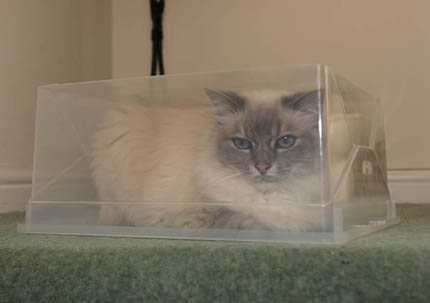
Cat in a Box! - Amusing photograph of our cat Ringo looking chilled out and relaxed, while tryiing out one of my storage boxes for size.
However, it does give a reasonable indication of how the EOS-1D and flash will work out it's own best settings to give a well exposed frame - notice how little reflection coming off the box and lack of any redeye
(ps - no cats mentally harmed taking this photo - he was more pissed off when I took it off!)

Not quite full resolution available, but click on this photo of Vincent Black Lightning rep to give an example of clarity and resolution given by Canon EOS 1D with decent lens (notice yellow numerals on Smiths rev clock)
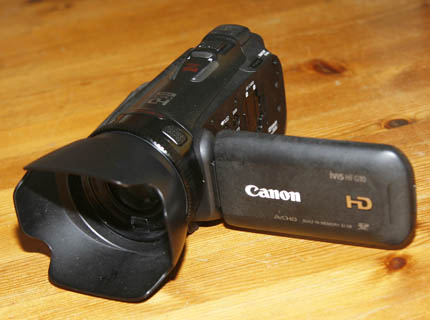
Canon Video Cameras:
I mention in this article that as well as using Canon digital camera's for 'Still' Photography, I also use a Canon Ivis HF G10 (Vixia HF G10 in UK, this was orgiinally a Japanese imprt version) HD video camera for the odd video -see Youtube under RacingVincent, for a couple of examples of these - although I confess the ones on Youtube are not my best examples, as I reduced quality on many to allow them to be more easily uploaded because of their Megapixel size.
I find this camera very handy because of its small size, ease of use and high quality images - therefore much easier for taking to bike meetings. As well as producing good quality HD 1064 videos, it has a prettty good 'Still' shot quality, and is good in low light. Definitely less bulky than the EOS 1D and lens!
The photograph below was taken at Founders Day Rally about 4 years ago - if you click on it you will see it also takes a nice crisp photo
Again, another Ebay purchase, but almost new when I purchased and if I remember correctly - it used their entry level Pro CMOS sensor and was considered a high end hobbyist aimed item. Although I dont use it a lot, I think it is excellent and would certainly recommend if you can still find a good second hand one available

Canon Lens Woes
The 28-70mm (without image stabilisation) was in reasonable nick when I purchased it - but had seen a fair bit of use - and because it was the model without stabilisation, I knew it was not the most recent version when I bought it. However - being their flagship aperure lens I really wanted to try it and knew I would never be able to afford one new. As can be seen in some of the accompanying pictures - the width of both the front and rear lens are massive - the front lens filter ring thread being 77mm - Canon's largest size. Incidentally, I always fit a good quality Skylight filter to all my lens (in the case of this lens a Hoya brand filter) - which is an essential, particularly using it in a workshop where it is very easy to knock the lens against something hard and sharp.
A brilliant lens though - and giving great quality photos (when I put my mind to it!), particularly in low light conditions
I gave this lens a lot of use and it worked great until about 18 months ago when its bayonet mount broke, and - much as I tried, could not be repaired. On reflection I blame myself for this - I was only semi aware that on using it a couple of times before it breaking, the lens did not feel fully secure to the body. The one disadvantage with this body and lens was - they were both heavy and bulky in weight - so as the bayonet mount screws loosened off - I should have done something about it immediately. Because I dident pick up on this fast engough, the screw fixings in the lens body eventually sheared - bugger.
I have to say, I was surprised on removing the outer body - the inner thread mounts seemed to be plastic (I may have got this wrong as it was difficult to see clearly) but although I did try and bore out and rethread, I think doing so damaged the electrics board behind them - as evertyhing was very close, and I then got camera 'ERR' messages when refitting. I did think about sending for repair, but new that would be really expensive and this was an older model.
Next Lens - Canon EF 24-105 4.0 L
But I had been so impressed by this lens that I did not want to go back to a non - L Series lens (by the way - these are easily identifiable in the Canon range by having a red band around their circumference) - so I went looking on ebay again and eventually bought the more up to date version, albeit I had to step down one notch on the aperture to the Canon EF 24-105 f/4.0 L series lens. A very similar lens in overall quality wiht slightly wider range, now having anti-shake functionality, but its maximum aperture now slightly reduced from f/2.8 to f/4.0 . . . I just could not find a decent second hand 2.8 version I could afford without need of a bank loan! (I believe the new price on this lens in 2.8 guise was in excess of £2k GBP. That said, as most of the time I use a flash, I dont really miss the 2.8's extra stop and this 4.0 L len's is considered one of the best (professional) general purpose len's available - covering the most useful focal range for everyday use, and image stabilisation helping if - like me, you rarely use a tripod.
In truth, as I use the camera most ot the time as a website 'workhorse', I dont think I am that much of an expert that with my limited skills I can even tell the difference!, it is still an awesome lens and gives excellent results - it is just the person pointing the lens that is at fault, I am still more than capable of taking crappy photos even with this lens - something I manage to do with regularity!
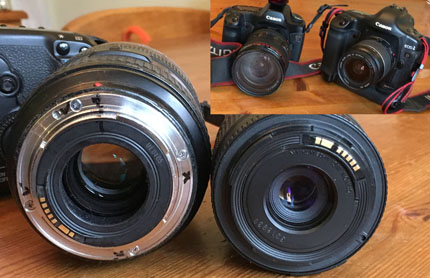
Lens Comparison: On the left - rear lens of the Canon L series 28-70 2.8 lens, while on the right is an almost standard Canon EF 28-80mm 3.5-5.6 V USM
the most obvious differerence is the vast size differences of the lens - the L series having an area that looks close to 3 times that of the standard lens - meaning far more light can pass through - but manufacturing a lens that big to remain of high quality costs a premium! - the stanard zoom on right used to ship with Canon DSLR kits and I gather retailed at about 120 GBP, while the L series 2.8 lens was excess of 2000 GBP when new
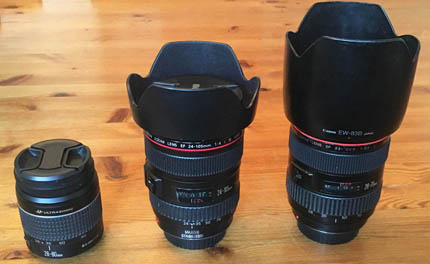
Lens Comparison 2 : On the far right is my original 28-70 f2.8 L series lens - unfortunately now faulty. In the middle its replacement - 24-105 f4.0 L series and on the right standard type 28-80 3.f5/5.6 EF lens
Notice though the later 24-105 benefits from the addition of Image Stabilisation
Canon Speedlite Flash Unit
I am still using this lens with the full format camera and they are a great combination - especially when combined with the Canon Speedlite 580EX, again, this model being Canon's premier 'L' series flash when new and also purchased second hand . .. as normal on my favourite retail outlet - E-Bay. This flash unit has ETTL (Evaluative Through The Lens) metering - whereby it shares the light meter in the viewfinder to measure ambient light, then performs a pre-flash before the main photo/flash is fired. It also has a Zoom head and a more powerful flash than other Speedlite's in the same range.
Again, this (Mk 1) version has now been superceded - but that is true of everything you buy, and does not decry from this versions features and ability - quality is always quality.
And this particular flash unit turned out to be true of what I have said already - if you shop carefully and dont mind taking a little bit of a risk - then it is possible to buy a really nice setup for a fraction of the cost new - I purchased this flash virtually new for a fraction of what its original retail price was.
If we are talking retail cost, as a total package of body/lens/flash (with the 2.8 lens and EOS 1D) the total setup would have been around £6-8000 new I guess - although I know when I purchased them they were @5 years old and did not have the very latest gizmo's and features - but were still far ahead in quality of what I could have afforded. I estimate I paid little more than £1,000 on ebay by waiting for the most favourable lisitngs.
As an aside, I know we all lament the passing of the high street shop sometimes, but this would have been nigh on impossible 20 years ago before E-bay, with most towns and cities only having a couple of photographic equipment shops selling good quality 2nd hand equipment and the range on choice far more limited - and therefore prices at a premium.
So for the last 5 years or more, this setup has been my main workhorse around the house and workshop - as well as occasional forays to meetings and family events when I can be bothered to carry it (it hs a large soft camera carrying bag, with spare batteries and filters etc). It has been an excellent camera for the website work - for when I am photographing a restoration article or Norton components to go on the website - although like with any camera, it does rely on the photographer being bothered to think about the subject matter they are photographing - and as I often just use it as an 'automatic' firing off frames on the settings made the last time I used it, while engrossed in the motorcycle item I am working on - it is no surprise I still seem to take an awful lot of crap quality photos! But cannot blame the camera for that.
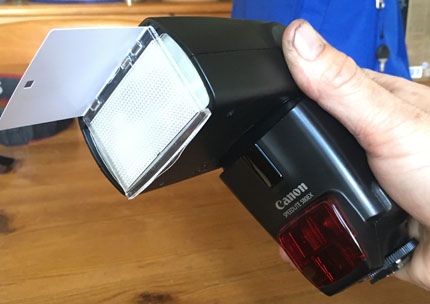
Caon Speedlite 580 EX flash unit. showing swivel head (which is also automatically telescopic) and infra red metering panel.
In this picture you can also see the flip out diffuser and reflector panel extended
Canon L Series Lens vs Standard Lens Comparison:
Canon EOS 1D goes faulty - and thinking about a replacement
Anyway, fast forwarding to the present - the other thing about the modern world compared to 50 years ago - it seems we are far more a society of throw away commodities? and with photography - like many other electrical items, new models are been announced constantly. But the flip side of this is that when something does goes wrong it is often cheaper just to replace, rather than repair. And this cost of repair seems to be exponential when trying to repair high quality or luxery goods - ask any 'would be' super car owner trying to repair their Ferrari or Maserati on a budget!
And so it was when my EOS 1D body developed a minor but annoying fault a few months ago. I noticed that when turning the camera on, I was semi-pressing the 'fire' button
to pre-focus the lens, and nothing was happening. After much experimentation and fiddling I found that if I removed the lens, ran my finger over the electrical contacts and the spring button on the bayonet, after a few attempts it worked properly again. In addition, some of the view functions on the rear LCD panel had the same issue, related to this same fault.
Annoyingly,
I could not find any consistency to this fault, sometimes it took a few seconds to reset, other times I had to disconnect and reconnect the lens at the bayonet fitting multiple times to get it to work - bloody annoying!
Apart from anything else, it meant I could not rely on the camera for anything that needed reliable and quick pictures - and even in the workshop where time was less of an issue, it quickly became a royal pain in the backside - much more so when I had oily hands and normally would only be touching the camera the very minimum to fire off a shot, but now had to be farting around disconnecting len's and rubbing connections with my oily mitts..
Although there was an immediate temptation to go a-hunting again on E-Bay for a more up to date version of the same EOS-1D body in a more recent model type (as this one had worked perfectly other than this recent annoying fault), I decided first to search out a Canon service centre that dealt with such cameras and then emailed them. No surprise to find that they were not keen to work on such an old version of this model, and as it was now out of support - they may not have spares if needed. Trying another place quickly confirmed it was not economically viable to have it repaired and just diagnosing the fault could easily cost more than it was worth.
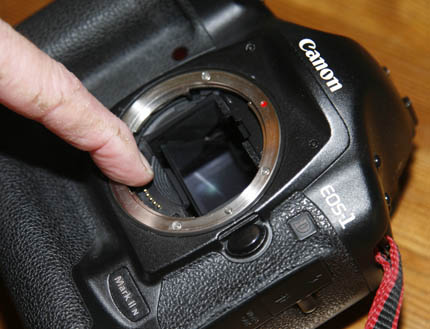
Annoying Fault on EOS 1D - As you can see here, the EOS 1D recently developed a fault where it would not pre-focus and take photos, without me first having to remove lens and rub electical contact and/or the small plunger on the bayonet ring next to the lens release button - what is that all about??!!
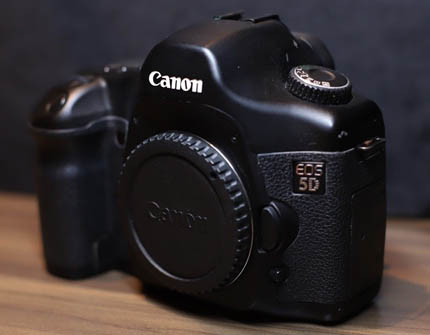
Canon EOS 5D MkI on Ebay - This was the body that eventually took my fancy. The buyer did not give a huge amount of background on it, but said it had been recently serviced at Canon and listing photographs like this one were nice and clear - so at just under £250 gave it a punt!
What to Replace Broken EOS 1D - And Is Size and Issue ???
So while considering a replacement - initially, I thought of looking for a more recent version of the EOS 1D, ideally a Mk IV or newer, but two factors led me to consider alternatives:
First of all, a later Mk IV (or X model that followed) body were more money than I wanted to spend - £700 or more seemed to be the starting price for anything half decent, and I did not really want to spend more than £500 at the time, having a lot of big manufacturing bills coming through at that time.
Added to that, one of the most obvious disadvantages of the EOS 1D body is its sheer size - it is a big heavy beast. Not really an issue around the workshop - but so often when going out somewhere when I might have considered taking the camera, I had decided not to bother because I could not be arsed to cart it around!
So, although not really that well up on the current range of Canon cameras, I had seen there was another full format Canon in the range - the Canon 5D, and had an idea they were up there in the list of top quality cameras avaiable.
Coincidentally, at the same time as I started looking around - one day while in my day job (I work in IT for a big UK home wares retailer), we had a visit from the photographic team taking some PR photos - I couldent help noticing one of them was using a recent model Canon 5D themselves, with a similar L series lense to mine, but overall the whole kit setup looked far more reasonable in size and bulk than the 1D arrangement. The photography team were in a bit of a rush - quickly going through the building, but I was still able to grab a couple of minutes with the one carrying the 5D, enough to confirm he liked it a lot and that was his main camera of choice.
Finding a Canon 5d body - and which variant?
So a quick scan of the internet and reviews confirmed that the 5D lineage started in 2006 and was now in its MkIV incarnation (early 2018). Although not having all the features of the EOS 1D in a year by year comparison - it was still a professional/semi-professional spec camera with full format and still very highly regarded. And similar to the EOS 1D - if you were not too worried about having the very latest features, and were prepared to live with the risk of buying an older model - the early ones were a great deal cheaper than buying new (as a comparision, articles at the time of first introduction had the 5D body at approx £3000 compared to the £6-8000 of the most expensive EOS-1D. By the way, if you are interested in looking for similar camera's yourself, and want to do a simple back to back comparison of Canon's DSLR range - then Wikipedia have an excellent page, which I used (and still use) a lot:
https://en.wikipedia.org/wiki/Comparison_of_Canon_EOS_digital_cameras
E-Bay - My favourite camera shop!
So looking at second hand prices, I could see the 5D MkII body (current model between 2009-2011) might just about be in my price range - setting myself a budget of £500. As always I started hunting on E-Bay, and as always, it was not long before I started seeing later MkIII models which were out of my price range - but making me think, 'if only I was to go over budget by another £200!'.
However, in a total reversal of the norm for me, in the end I went in the opposite direction and bought an original MkI Canon 5D (what some refer to now as the 5d Classic) - because the listing looked genuine and the camera
very good value. If truthful, it was also an auction, rather than a 'Buy It Now', and I noticed the time it was due to finish was in the middle of a weekday - something I have found to give far better chance of a bargain in the past! I know buying an older version of high spec cameras like this can have its risks and drawbacks, but if you are interested, I found this useful article reviewing the similar MkI 5D, but from the perspective of a review now of what is a now an old model, comparing it to the newer models:
https://www.dpreview.com/articles/5197378415/throwback-thursday-the-canon-eos-5dv
So, I made a note of the time and kept an eye on the price - which was not moving much, so logged in to E-bay on the day the auction finished and was able to buy the camera body for the very reasonable sum of £243, which included two chargers a couple of spare batteries and three flash cards.
The description looked reasonable without giving too much of its history - but described the camera as very good fully working condition and had recently been serviced at a main Canon dealer and had had the mirror replaced.
About a week later the camera safely arrived - and I was pleased to see that everything the previous owner had said about the overall quality of the camera looked spot on - it seemed a very clean example with almost no obvious signs of wear, and as far as I could tell - all functions and electronics working well.
A High Quality Camera for £250 - Great Value For Money
I think the other thing that was going through my mind in going for an earlier version - buying a camera body for @£250 is a very cheap outlay from the perspecive of it being a necessary tool for my website and Norton parts business.
However, my rationale was - it may be worth limiting the amount of money I spend now, so if I do like the feel and features of the earlier 5D camera - it might incentivise me to invest a more substantial amount of money in a later MkIII (or possibly even MkIV version) sooner - rather than that middle ground of spending @£500'ish now, where for that amount of money spent i would feel more inclination not to replace it without getting at least a couple of years usage first.
And this has turned out to be the case so far - having now had the camera for almost 3 months, I am already enjoying using it - it has the excellent build quality you come to expect from Canon - it feels robust, ergonomic to hold - and most importantly for me - feels much lighter and less bulky than the previous EOS 1D.
As far as photographich quality and functionality - well I have only had it for 3 months, but it seems pretty much on a par with the EOS 1D - i..e very good, and it is certainly nice to have everything back working again - I can just point and shoot again.
As far as features and spec are concerned, it's general button and display ergonomics are similar to the layout of my EOS-1D MkII - not surprising considering they are roughly of the same age.
Differences in Design
The main difference in layout (other than the EOS 1D being deeper and having an additional small LCD under the main LCD on the back panel) is that the 5d has an old style dial button on the top panel, left side - which is used to select the different program modes, similar to most old style SLR pre digital cameras. However, this dial is easy to use and I like it - it is just different to EOS 1D design where you press a button on the left and use a dial on the right side to change the program mode .
The screen size are similar as well - both being 2.5". With the later models this LCD size got increasingly bigger with each model variant. The current 5D MkIV
and EOS 1D X MkII are both 3.2" and 1620k resolution touchscreen - I think that must make a lot of difference as I notice sometimes it is difficult to view a photo through the LCD clearly on my 2.5" versions - added to which anyone with an Iphone quickly gets used to a touchscreen - I sometimes find myself trying to enlarge the photograph on these camera screens with my fingers and then remember they are not touchscreen and get annoyed!
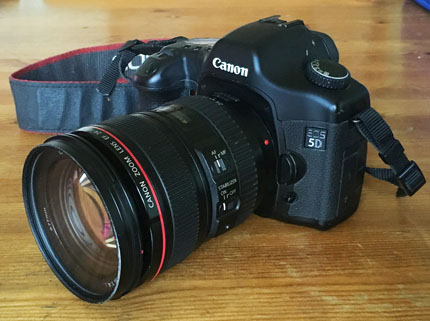
Canon EOS 5D: And So here is the 2nd hand body when it arrived, and fitted up to my 24-105 4.0 L series lense - which I had previously fitted to the EOS 1D
Very pleased to find it looked just as good as in photos and seems to work perfectly - always a bit of a concern when buying second hand
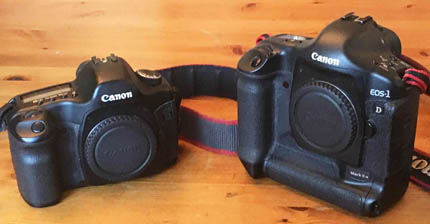
Comparison of body size between EOS 5D on left and EOS 1D on right. Both are of approximate 2006-2008 vintage, so later versions have bigger LCD screens at back and other minor differences in later versions - however you can see the 5D looks noticeably smaller size - much of this bulk being the reduction in size of battery, which in the 5D sits in the pistol grip, while on the 1D it is in the lower part of the body - great I am sure when new, but no benefit when the battery starts to get tired and costs a fortune replace!
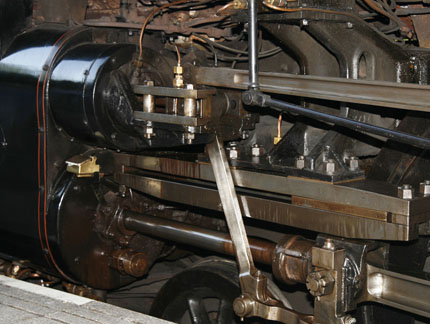
First Time Out With Canon 5D: As it happened, first weekend of having the EOS 5D coincided with a family visit to Loughborough Great Central Railway, for an evening Fish Supper event. While waiting at the platform for the return journey I snapped off this interesting shot of pacific locomotive Oliver Cromwell
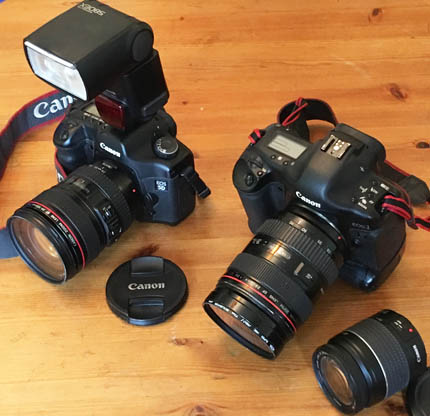
Another picture of both camera's together - EOS 5D with f/4.0 lens on left and the faulty EOS 1D with f/2.8 lens on right for size comparison. I may still try and strip the 2.8 lens again and consider trying to replace the electric panel - it seems a shame not to try when it is such a good lens - but with the cheaper lens the EOS 1D is still a workable spare
Canon EOS 5D - A few Photographs So Far:
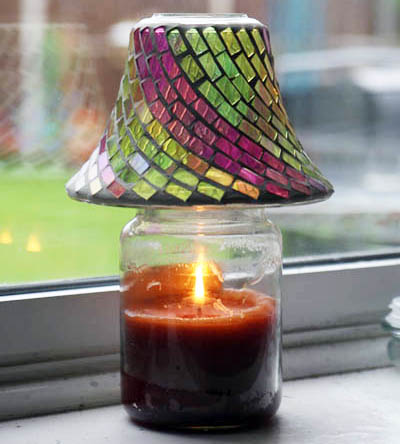
First picture with the Canon 5D. This in my back office room at home (with smelly candle alight on the window) I just put a lens on it, turned it on and pointed it at the candle. Taken without flash, and not having adjusted ISO rating - not bad and at least it works!
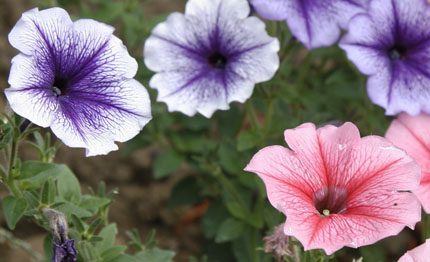
Flowers in the back garden. Not my normal photographic subject matter but they looked nice and a chance to try out the EOS 5D
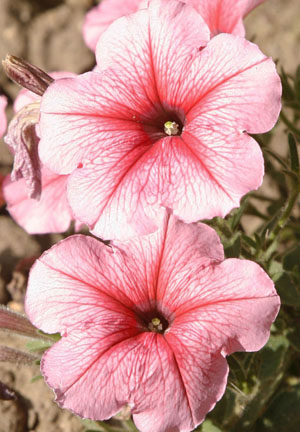
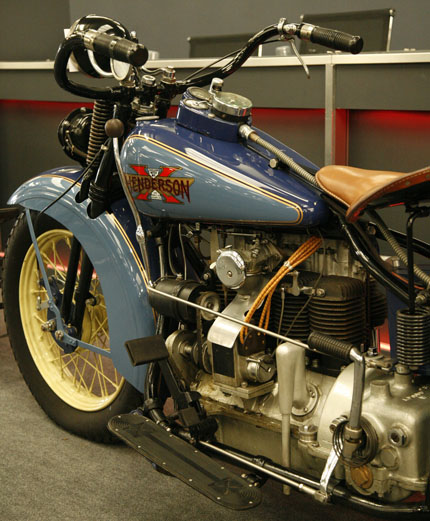
Taken at October Bonhams auction at Stafford (I will be doing a future article of this event) - this shot of 1930's Henderson was taken in the auction room.
No flash used- ISO was set to maximum 3200, shutter at 1/60 sec, L series 24-105 lens at f4.5 aperture rating
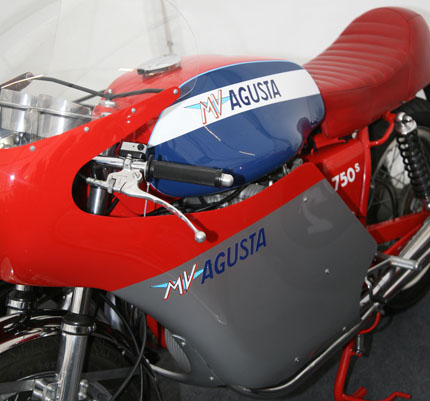
MV Augusta 750 also photographed at Bonhams Stafford Auction.
Settings for this photograph - 1/60 shutter, ISO 400, 24-105 L series on 5d the lens at 47mm. For this shot Canon Speedlite 580 EX fitted and was in Compulsory mode with Evaluative metering. I only know this because the camera makes a note of all the settings - very handy!
Not amended in photoshop, other than cropping and reducing image size (click picture above to see this cut down image - about half the original size)
Latest Trends - Mirrorless Technology
I said early on in this article that I am not really up on latest trends in photography, but I do know that there is currently a major revolution going on in the DSLR market with the recent introduction of 'mirrorless' cameras.
As the name suggests, this technology dispenses with the mirror in the normal DSLR camera and means the subject matter is played directly on to the sensor.
There are supposedly numerous advantages to this - but even better low light features, a much quieter operation (without the mechanical mirror mechanism) and a host of other cutting edge features are being talked about.
Even 'eye recognition' and 'animal recognition' when metering are being talked about - opposed to just multi-point, which could revolutionize portrait photography - cutting edge stuff.
I gather Sony were one of the first to introduce this technology about 3 years ago, with Nikon and Fuji following suit - but Canon are only just doing so now, and are just in the process of releasing their first Full Format mirrorless professional camera - the EOS R in October 2018
(see picture alongside). This camera utilises full format, but mirrorless technology, and also uses their new era of RF type lenses, which sound like they will eventually replace the EF fitting lenses shown in this article.
As well as being mirrorless, this latest Canon offering provides 30.3 megapixel dual pixel CMOS AF sensor - compared to the 12.8 megapixels of my MkI 5d and only 8.2mp of the MkIIn EOS 1D.
It has an ISO range from 100 to an unbelievable 40,000. Compare this to the the MkI 5D which can manage a max ISO1600 (which was cited as one of its limitations compared to the EOS 1D of similar era) - but even my EOS MkII has only a maximum rating o f ISO3200, and I thought that was a revolution when i first got it - I can remember the days where you bought non digital Kodak film by its ISO/speed rating - and even ISO400 was considered a 'high speed' film, how things have changed!)
It sounds very interesting stuff - and like anyone with an interest in photography, reading about this technology or watching promo videos give you the curioisity to want to go out and try it for yourself - but one possible knock on to this could be that their is a bigger shift towards professional mirrorless cameras in the next couple of years - and the opportunist in me tells me that means some of the more recent full format mirror type bodies could be even more affordable on the second hand market.
Summary
From my own viewpoint - yes it would be nice to buy a brand new camera with all the latest features mentioned in the article, but for my purposes, most of them are niceties - and so far I have found the camera to be great quality, easy to use and frankly - brilliant value for money. Come back to me in a year or two's time and I will tell you if it is still working - but if you are considering buying second hand yourself and fancy a camera of excellent pedigree, then I hope this article gives you an useful insight and the confidence to know - there are bargains to be had!
That said, as part of writing this article I ended up having to re-aquaint myself with the latest Canon offerings - and actually came to thinking that the new EOS-R looks pretty good value for money, compared to the price of buying an EOS 1D back in 2006, even I (a skinflint who has always preferred buy a secondhand model at a fraction of the new retail cost) has been tempted to hold off and consider looking at the new mirrorless range - as it seems very competively priced
compared to 5D price and similar. Not quite there yet, but will be watching carefully once it is released and might hold off upgrading my 5D Classic for a more up to date offering until I see how the EOS - R is performing.
So, I hope this article has been useful to you - and what I would say is - if you like the idea of doing more photography of your bike hobby (or anything else for that matter), but have never thought of looking at a DSLR camera because you have thought them too expensive or complex - maybe think about going the route I like to do, and think about buying something decent - from my own perspetive I will still keep going down the Canon route - happy clicking!
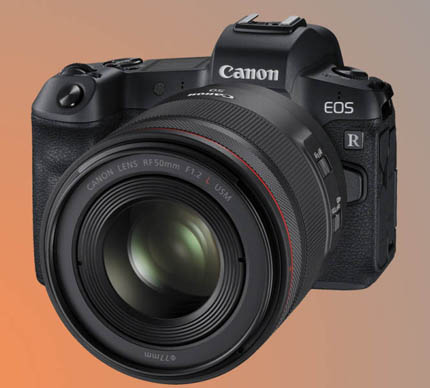
Caon EOS R - Mirrorless DSLR
Canon's latest generation of DSLR camera using mirrorless technology. Due for release in October 2018. Think I will have to wait a while before looking for a 2nd hand version of one of these!
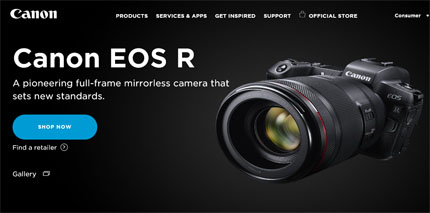
Caon EOS R - Reasons to Buy?
As part of writing this article I had to remind myself what the current (2018) technology was. When I started reading about the new EOS R range, even a skinflint like myself started considering if their new EOS R camera was worth switching to now - rather than investing in a 10 year old Canon 5D? The entry price looks very reaonable and they offer an adaptor for those that already have a considerable investment in L Series EF lens, to allow them to be retro fitted to the new Canon lens fitting. Check out their website like I did by clicking on this photo . . . even I am thinking about it!


